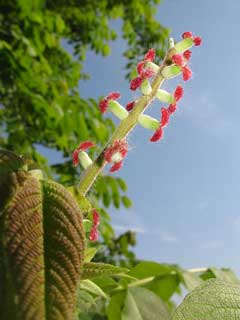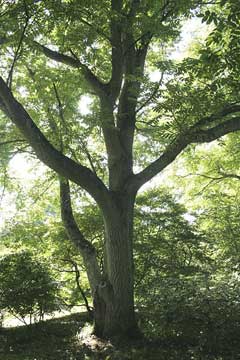 |
|
http://commons.wikimedia.org/wiki/User:Qwert1234 |
 |
| http://commons.wikimedia.org/wiki/User:Jean-Pol_GRANDMONT |
Translate this page:
Summary
Physical Characteristics

 Juglans mandschurica is a deciduous Tree growing to 20 m (65ft 7in).
Juglans mandschurica is a deciduous Tree growing to 20 m (65ft 7in).
See above for USDA hardiness. It is hardy to UK zone 5. It is in flower from May to June, and the seeds ripen from September to October. The species is monoecious (individual flowers are either male or female, but both sexes can be found on the same plant) and is pollinated by Wind. The plant is self-fertile.
Suitable for: light (sandy), medium (loamy) and heavy (clay) soils and prefers well-drained soil. Suitable pH: mildly acid, neutral and basic (mildly alkaline) soils. It cannot grow in the shade. It prefers moist soil.
UK Hardiness Map
US Hardiness Map
Synonyms
Plant Habitats
Woodland Garden Canopy;
Edible Uses
Edible Parts: Oil Oil Seed
Edible Uses: Oil Oil
Seed - raw or roasted[183]. The kernels are well filled but difficult to extract because the shell is thick[74, 117, 183]. An edible oil is obtained from the seed[105, 183], it tends to go rancid quickly.
References More on Edible Uses
Medicinal Uses
Plants For A Future can not take any responsibility for any adverse effects from the use of plants. Always seek advice from a professional before using a plant medicinally.
Cancer Miscellany
The cotyledons are said to be a cure for cancer[218].
References More on Medicinal Uses
The Bookshop: Edible Plant Books
Our Latest books on Perennial Plants For Food Forests and Permaculture Gardens in paperback or digital formats.

Edible Tropical Plants
Food Forest Plants for Hotter Conditions: 250+ Plants For Tropical Food Forests & Permaculture Gardens.
More

Edible Temperate Plants
Plants for Your Food Forest: 500 Plants for Temperate Food Forests & Permaculture Gardens.
More

More Books
PFAF have eight books available in paperback and digital formats. Browse the shop for more information.
Shop Now
Other Uses
Herbicide Miscellany Oil Oil Rootstock String Wood
The seed contains up to 52% oil and, as well as being edible, it has industrial uses[74]. A rope is made from the bark of young trees[74]. Plants produce chemicals which can inhibit the growth of other plants. These chemicals are dissolved out of the leaves when it rains and are washed down to the ground below, reducing the growth of plants under the tree[18, 20, 159]. The roots of many members of this genus produce substances that are toxic to many plant species, especially apples (Malus species), members of the Ericaceae, Potentilla spp and the white pines (certain Pinus spp.)[200]. The inner bark is used to make heel pieces for straw shoes[151]. Sometimes used as a rootstock to confer greater cold resistance[183]. Wood - hard, durable. Used for veneer, furniture etc[46, 61, 74].
Special Uses
References More on Other Uses
Cultivation details
Requires a deep well-drained loam and a sunny position sheltered from strong winds[1, 11]. Prefers a slightly alkaline soil[200]. A very hardy and ornamental tree[1], it is recommended for cultivation in severe cold climates[183]. Plants produce a deep taproot and they are intolerant of root disturbance[1, 11]. Seedlings should be planted out into their permanent positions as soon as possible and given some protection for their first winter or two since they are somewhat tender when young[1, 11]. Flower initiation depends upon suitable conditions in the previous summer[200]. The flowers and young growths can be destroyed by even short periods down to -2°c, but fortunately plants are usually late coming into leaf[200]. Any pruning should only be carried out in late summer to early autumn or when the plant is fully dormant otherwise wounds will bleed profusely and this will severely weaken the tree[200]. Trees have a dense canopy which tends to reduce plant growth below them. We have no specific information for this species, but the roots of several members of this genus produce substances that are toxic to many plant species, especially apples (Malus species), members of the Ericaceae, Potentilla spp and the white pines (certain Pinus spp.)[200]. The leaves of many species also secrete substances that have an inhibitory affect on plants growing underneath them. All in all this is not a very good companion plant[K]. Closely allied to J. cathayensis[11].
References Carbon Farming Information and Carbon Sequestration Information
Temperature Converter
Type a value in the Celsius field to convert the value to Fahrenheit:
Fahrenheit:
The PFAF Bookshop
Plants For A Future have a number of books available in paperback and digital form. Book titles include Edible Plants, Edible Perennials, Edible Trees,Edible Shrubs, Woodland Gardening, and Temperate Food Forest Plants. Our new book is Food Forest Plants For Hotter Conditions (Tropical and Sub-Tropical).
Shop Now
Plant Propagation
The seed is best sown as soon as it is ripe in individual deep pots in a cold frame[80]. You need to protect it from mice, birds, squirrels etc. The seed usually germinates in late winter or the spring. Plant out the seedlings into their permanent positions in early summer and give some protection from the cold for their first winter or two. The seed can also be stored in cool moist conditions (such s the salad compartment of a fridge) over the winter and sown in early spring but it may then require a period of cold stratification before it will germinate[78, 80, 113].
Other Names
If available other names are mentioned here
Native Range
Coming Soon
Weed Potential
Right plant wrong place. We are currently updating this section.
Please note that a plant may be invasive in one area but may not in your area so it's worth checking.
Conservation Status
IUCN Red List of Threatened Plants Status :

| Related Plants
|
| Latin Name | Common Name | Habit | Height | Hardiness | Growth | Soil | Shade | Moisture | Edible | Medicinal | Other |
| Juglans ailanthifolia | Japanese Walnut | Tree | 20.0 |
4-8
| | LMH | N | M | 3 | 1 | 5 |
| Juglans ailanthifolia cordiformis | Heartseed Walnut | Tree | 20.0 |
4-8
| M | LMH | N | M | 4 | 1 | 4 |
| Juglans californica | California Walnut, Southern California walnut | Tree | 6.0 |
7-10
| M | LMH | N | M | 2 | 1 | 3 |
| Juglans cathayensis | Chinese Walnut | Tree | 20.0 |
4-8
| | LMH | N | M | 3 | 0 | 1 |
| Juglans cinerea | Butternut - White Walnut, Butternut | Tree | 25.0 |
3-7
| M | LMH | N | M | 3 | 3 | 3 |
| Juglans hindsii | Hind's Black Walnut, Northern California walnut, Paradox hybrid walnut | Tree | 15.0 |
8-9
| M | LMH | N | M | 3 | 0 | 3 |
| Juglans intermedia | Hind's Black Walnut, Northern California walnut, Paradox hybrid walnuH | Tree | 30.0 |
4-8
| | LMH | N | M | 3 | 0 | 1 |
| Juglans major | Arizona Walnut | Tree | 15.0 |
8-11
| F | LMH | N | M | 2 | 0 | 2 |
| Juglans microcarpa | Texas Walnut, Little walnut, Stewart's little walnut | Tree | 10.0 |
5-9
| | LMH | N | M | 2 | 0 | 3 |
| Juglans neotropica | Andean Walnut | Tree | 25.0 |
10-12
| S | LMH | N | M | 3 | 2 | 4 |
| Juglans nigra | Black Walnut | Tree | 30.0 |
4-9
| F | LMH | N | M | 3 | 3 | 4 |
| Juglans olanchana | Olancho walnut, Central American walnut | Tree | 45.0 |
10-12
| M | LMH | SN | MWe | 2 | 0 | 3 |
| Juglans regia | Walnut, English walnut, Persian Walnut, | Tree | 20.0 |
7-9
| M | LMH | N | M | 4 | 3 | 4 |
| Juglans regia fallax | Walnut | Tree | 30.0 |
4-8
| | LMH | N | M | 3 | 0 | 1 |
| Juglans regia kamaonia | Walnut | Tree | 30.0 |
4-8
| | LMH | N | M | 3 | 3 | 3 |
| Juglans sinensis | | Tree | 20.0 |
-
| | LMH | N | M | 3 | 1 | 1 |
| Juglans x bisbyi | Buartnut | Tree | 20.0 |
4-8
| | LMH | N | M | 3 | 0 | 2 |
|
Growth: S = slow M = medium F = fast. Soil: L = light (sandy) M = medium H = heavy (clay). pH: A = acid N = neutral B = basic (alkaline). Shade: F = full shade S = semi-shade N = no shade. Moisture: D = dry M = Moist We = wet Wa = water.
Now available:
Food Forest Plants for Mediterranean Conditions
350+ Perennial Plants For Mediterranean and Drier Food Forests and Permaculture Gardens.
[Paperback and eBook]
This is the third in Plants For A Future's series of plant guides for food forests tailored to
specific climate zones. Following volumes on temperate and tropical ecosystems, this book focuses
on species suited to Mediterranean conditions—regions with hot, dry summers and cool, wet winters,
often facing the added challenge of climate change.
Read More
Expert comment
Author
Maxim.
Botanical References
1174200
Links / References
For a list of references used on this page please go here
Readers comment
© 2010, Plants For A Future. Plants For A Future is a charitable company limited by guarantee, registered in England and Wales. Charity No. 1057719, Company No. 3204567.